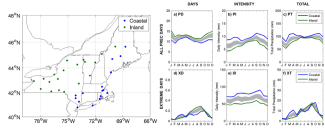The Climatology of Extreme Precipitation in the Northeast US
Extreme precipitation and associated flooding has a high societal and economic cost. In the Northeast US extreme precipitation has increased by more than 70% in the last 50 years and is projected to continue to increase. Recent work by Agel et al. provides a detailed regional analysis of the seasonal and spatial distribution, time-scale, and contributing large-scale factors associated with extreme short-term precipitation in the Northeast. This serves as a foundation for investigating the underlying dynamics and potential future changes.

This figure shows on the left) coastal (blue) and inland (green) separation of USHCN (United States Historical Climatological Network) stations, and right) climatology of the associated precipitation frequency, daily intensity, and total precipitation by month, separated into all precipitation days in the upper panels, and extreme (99th percentile) precipitation only in the lower panels. The grey shading shows 95% confidence interval of the seasonal cycle due to random shuffling of precipitation between stations, confirming the difference in coastal and inland characteristics.
Using daily station-based precipitation records from the United States Historical Climatological Network for the years 1979-2008, it is found that there are two distinct sub-regions. The figure shows the spatial distribution of stations and the seasonal cycles, with results for all precipitation days included for comparison with extremes. For both subregions, extreme daily precipitation (99th percentile) occurs more often in warm months, but surprisingly, the intensity of extreme precipitation is roughly constant regardless of season, with coastal intensity consistently higher than inland intensity. In general, the majority of all precipitation occurs as isolated 1-day events, while most extreme precipitation occurs over a period of several hours embedded within 2-5 day events. Over 75% of the Northeast short-term extreme precipitation is related to extratropical storms moving through or near the region, except during September, when more than 50% of extreme precipitation is related to tropical storm activity.
Climatology of Daily Precipitation and Extreme Precipitation Events in the Northeast US (Journal of Hydrometeorology)
1University of Massachusetts Lowell
2University of Massachusetts Boston
3University of St. Louis
